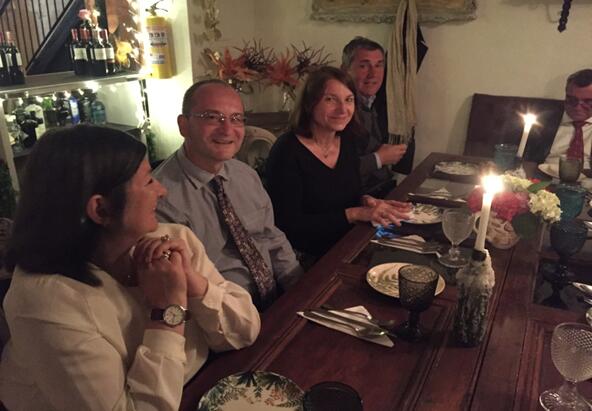
捷克共和国老年大学
 简介
简介
捷克共和国老年大学的游学之旅

老年大学在布拉格查理大学胡斯特神学院的短途游学由作者负责组织。
首先,关于查尔斯大学。查尔斯大学于1348年由捷克国王和神圣罗马帝国皇帝查理四世在布拉格创立。它不仅是捷克最古老的大学,也是中欧最古老的大学。其在各个时代经历了许多变化,这与动荡的政治事件有关。15世纪初大学的校长之一是扬·胡斯(Jan Hus),他也是第一次宗教改革的先驱,同时有以他名字命名的学院。目前,查尔斯大学有17个学院,近5万名在校学生。
捷克的老年大学教育始于20世纪80年代。第一个老年大学于1986年开始在奥洛穆茨大学设立。一年之后,另外一所老年大学在布拉格的查尔斯大学第一医学院设立。1990年以后,老年大学在捷克高校中呈现显著的增长,特别是布拉格查尔斯大学。目前,近7000名老年人参与了该校的老年大学计划,这是所有捷克高校中数量是最多的。老年大学的入学人数的增加与捷克共和国老年人口和平均年龄的增长有关。1990年,公民的平均年龄为36岁多一点,而2016年为42岁。退休年龄也在增加。根据当代立法,1965年以后出生的人将在65岁时退休。
人口年轻的增加和更好的医疗保健将使得老年人的整体状况更佳,并且活跃的老年人而言他们有更多的选择。其中一部分原因也包括游学和旅行活动。虽然目前只有一小部分有兴趣保持较高精神状态的老年人选择游学和旅游,但这个群体正在稳步增长。
查尔斯大学胡斯神学院的老年大学活动:
作为夜间神学院的一部分,这里的老年教育始于20世纪90年代初。自1999年以来,老年大学在被称为“代际对话”项目中完成了改造。它包括日常课程和老年人的共同教育。除了语言课程外,老年人可以参加认证学习课程的任何科目,并与其他学生一起完成这些科目。“代际对话”非常成功,因为让所有参与者彼此充实。从2008年开始,当作者负责老年大学组织时,这种形式的教育通过一系列专为老年群体组织的文化历史讲座得到了进一步的延伸。该系列主题侧重于某些历史时期或现象,并经常考虑历史周年纪念事件。胡斯神学院的老年大学项目参与者人数稳步上升 - 在10年内约上升了500% - 这证明了它的受欢迎程度。
自2008年以来,老年大学为学员们每年组织两次短途游学。这些是除文化历史讲座系列之外老年大学的另外一项主要业务,而且是学院所特有的。短途游学的部分资金由老年人承担,部分来自学院的老年大学预算。最初的短途旅行只有一天,然而在2009年4月第一次组织了为期两天的短途旅行。它被称为“从胡斯到银矿”,学员们参观了重要的捷克中世纪银矿开采城市库特纳霍拉,并了解了15世纪胡斯宗教战争的重要事件。在接下来的几年中,这些短途旅行不仅在捷克共和国境内,而且还延伸到了国外。
与一些系列讲座类似,短途游学也在主题上与重要的周年纪念相关。2015年为捷克神学改革家扬·胡斯(Jan Hus)殉道600周年,因此老年大学组织了“重走扬·胡斯和他的追随者走过的土地”的周年纪念游学活动。第二年,在捷克国王和罗马皇帝查尔斯四世的诞生700周年之际,老年大学又组织了一次短途游学。去年的两次短途旅行为了纪念马丁·路德1517年新教改革,学员们到访了德国和捷克共和国与这个改革家有关的地方。例如德国的维滕贝格市、沃特堡城堡或捷克城镇雅克摩夫。
短途旅行的特点已经改变。正如之前提到的从一天到多天的变化。自2011年以来,每次短途旅行都有与行程和旅行内容相关的主题清单。参与者分别准备一份简短的演示文稿并在短途旅行期间分享。(本论文保存于学院的的研究部门。)这些游学的特点是强调高等教育质量的重要性。因此,短途旅行被认为是一个实际的研讨会,其反映了大学的高等教育的性质,而不仅仅是一次去国外的说走就走的旅行。
在准备短途旅行期间,需要考虑诸多方面。对于交通工具,学员们选择公共汽车或小型巴士,具体取决于参与人数。因此,必须考虑到旅程的长短,这将受到欧洲交通法的限制。在计划准备中需要考虑到这一点。例如:在一定的旅行时间后,必须停留9小时 - 这个停留应考虑在休息时间或者某个地点的全天计划中。根据时间选项对计划进行准备。短途旅行的领导者必须掌握到访地点的充分信息,因为这些地点必须适合老年人的生理需求。还有必要提前预订门票和住宿。考虑到参与者的年龄,有必要计划更为频繁的休息。
老年大学的学生也从游学中受益,老年大学定期为更大范围的学校公众群体组织终身学习活动。所产生的费用完全由参与者承担。即使如此,这些旅行的参与者大多是老年人。与老年大学计划中组织的短途旅行相反,这些旅行的目的地始终是国外。与U3A的短途旅行类似,参与者也提交主题论文 - 他们可以从主题列表进行选择。
鉴于作者是捷克-意大利关系专业的历史学家,这些短途游学主要是对意大利进行探访。他会考虑周年纪念活动,并准备专题计划。正如前面提到,在2016年,两次前往意大利的旅行的动机都是查尔斯四世国王在意大利的停留。学员们参观了摩德纳附近的圣菲利斯城堡,在那里当时只有16岁的国王参加了他的第一次重要战役,还有罗马,哪里是国王皇室加冕典礼的地方。
这些旅行对身体的要求很高:第一天学员们早上从布拉格出发,这样可以在当天游览行程的第一站,之后在大巴车上度过一晚(大部分情况下是返程)。今年的游学没有前往意大利,而是前往波兰和乌克兰西部,这第一次世界大战的周年纪念日有关。学员们访问的特殊场所是一个名为兹博里夫的乌克兰小村庄,那里举行着名的捷克战役。这次行程也与一系列讲座的主题有关,这些讲座围绕捷克斯洛伐克共和国建国100周年展开。
查尔斯大学的其他学院也组织了老年大学的游学活动。这些活动大多是系列讲座的一部分,而且参与者并没有积极准备自己的展示。例如,查尔斯大学哲学系拥有最多数量的老年大学学员(超过整体数量的一般),但他们只组织一天的考古和历史方面的游学。
捷克共和国的其他大学也组织了老年大学的游学活动。比如,比尔森西波希米亚大学正在开展一项自然科学研究项目,此项目已经进行了数年,并且旨在推动此领域的教育。参与者在困难的地形中行走在大自然中,即便是道路被积雪覆盖或者非常滑。而这些困难对许多参与者而言相当有吸引力。
游学可以通过非正统的方式来加深学生的学术知识。并且其可以实现学生对活动的主动参与。新的发现和访问地点可能会激励学生继续学习,并有助于他们获得新的体验。在某些方面,短途游学可以被看作是一次度假旅行(学生热情、愉快,分享的分享着他们的时光等等)。另一方面,人们必须学会尊重他人。例如,在其他人进行陈述的时候,任何人不得交谈。他们必须遵守游学的形成并且按照正常的时间表进行。短途游学使得学员们必须遵守集体计划,让他们习惯大巴车旅行并且有守时的观念。但他们同时还需要学会在语言不通的异国寻找路线和确定方位。短途游学是社交和提升老年人自律性的很好方式。
Educational excursions of the University of the Third Age in the Czech Republic
This paper will be focused on the organization of tourism for seniors in the programme of the University of the Third Age in the Czech Republic. Special attention will be paid to the excursions of the University of the Third Age at the Hussite Theological faculty of the Charles University in Prague, where the author is responsible for the organization of such activities.
Firstly, it is the presentation of the Charles University. It was founded by the Czech king and Emperor of the Holy Roman Empire Charles IV in Prague in the year 1348. It is not only the oldest university in Czech Republic but also the oldest university in the Central Europe. It underwent many changes during the ages, which were related to tumultuous political events. One of the rectors of the university in the beginning of the 15th century was Jan Hus, after whom the medieval religious movement is named, sometimes referred to as the first reformation, and after the faculty is named. Currently the Charles University consists of 17 faculties and almost 50 000 students are studying there.
University education for seniors in the Czech Republic has its beginning in the eighties of the 20th century. The first Universities of the Third Age started their activities at the University of Olomouc in the year 1986 and a year after in Prague at the First medicine faculty of the Charles University. After 1990, the Universities of the Third Age occurred a significant growth at the Czech universities, and particularly at the Charles University in Prague. Nowadays almost 7 000 seniors are involved in the programme of U3A, which is the highest number of all Czech universities. The rise of enrolled participants in the programmes of the University of the Third Age is related to the growth of the number of seniors and the average age of the population of the Czech Republic. If in the year 1990 the average age of a citizen was slightly over 36 years, in 2016 it was 42 years. The retirement age is also raising. According contemporary legislative, people born in the year 1965 and after will retire at the age of 65.
The rising age of the population and better health care goes hand in hand with better overall condition for seniors and special options for an active older age. Part of that is also studying and travelling activities. Only a small part of the senior population which has an interest in maintaining a higher mental condition embraces them, but this group is steadily growing.
The activities of the University of the Third Age at the Hussite Theological faculty of the Charles University:
The education of seniors here started in the early nineties of the 20th century as a part of the Evening theological school. Since 1999 the University of the Third Age has been transformed in the project of the so-called Generation Dialogue. It consists in the jointly education of the students of daily courses and the seniors. The seniors may be enrolled in any subject from the accredited study courses with the exception of language courses, and complete it together with the other students. Generation dialogue is very successful because it leads to the mutual enrichment of all its participants. From the year 2008 onward, when the author took over the organization of the University of the Third Age at the faculty, the offer of this form of education was expanded by a series of cultural-historical lectures organized only for a senior audience. The series are thematically focused on certain historical periods or phenomena, and often consider historical anniversaries. The steady rise of participants of the U3A program of the Hussite Theological faculty – in ten years approximately of 500% - is testimony to its popularity.
Since 2008, an educational excursions organized for students of U3A twice a year. These are next to the series of cultural-historical lectures one of the main offers of U3A, and the faculty is unique for this. The excursions are financed partly by the seniors, partly by the faculty from the U3A budget. At the beginning the excursions were only one day long, however in the April 2009 the first two-day excursion was organized. It was called “Between Silver and Hussite”and we visited Kutná Hora, an important Czech medieval city, where silver was mined, and saw the places of important events of the Hussite religious wars of the 15th century. In the following years the excursions were aimed not only at places in the Czech Republic but also at the foreign countries.
Similarly to some series of lectures, the educational excursions were thematically linked to important anniversaries. In the year 2015, there was the anniversary of the death of Czech theological reformer Jan Hus who was burned 600 years ago and therefore the excursion “Through the land of Jan Hus and his followers”took place. The next year the excursions followed the footsteps of Czech king and Roman Emperor Charles IV, on the occasion of the 700th anniversary of his birth. Two last year’s excursions were inspired by the anniversary of Martin Luther’s protestant reformation in 1517 and lead to the places connected with this reformer in Germany and the Czech Republic. For instance the German city of Wittenberg, castle Wartburg, or the Czech town Jáchymov.
The character of excursions has been changed. It has already mentioned the change from one-day to multi-days ones. Since 2011, each excursion has been having a list of topics related to the itinerary and the content of the trip. Participants individually prepare a short presentation and present it during the excursion. (The paper is kept in the study department of the faculty.) The character of these educational excursions stresses the importance of the quality of higher education. Therefore the excursions are considered as a practical seminar which reflects the nature of the higher education of the universities and not only a casual trip abroad.
Many aspects are necessary to take into account during preparation of the excursion. For transport the senior students use a bus or a micro-bus, depending on the number of participants. Therefore the length of the journey must be taken in consideration, which is limited by European transport law. The programme is prepared with that in mind. For example: after a certain amount of time it is mandatory to take a 9 hours pause – this break should be integrate in the resting time or in a whole day programme in one place. Programme is prepared according to time options. The leader of the excursion must have enough information about the visited places, because the locations must be suitable to the physical needs of the seniors. It is also necessary to have the entrance tickets and the accommodations booked in advance. In regards to the age of the participants it is necessary to plan more frequent stops.
The U3A students also benefit from the educational excursions, which the U3A regularly organize for the larger university public in the context of so called lifelong learning. They are completely financed by the participants. Even so the participants of these trips are mostly seniors. On the contrary to the excursions organized in the programme of the University of the Third Age, these trips are always aimed at foreign countries. Similarly to the excursions of U3A participants also present a thematic paper – they can chose from the list of topics.
These educational excursions, which due to the author’s profession of the historian with a specialization on Czech-Italian relationship, explore mainly Italy. He also take in consideration anniversary and prepare thematic programme. In the year 2016 both excursions to Italy were motivated by the Italian stays of the above mentioned King Charles IV. The senior students visited for example Castle San Felice near Modena, where at the age of 16 he fought his first important battle, or Rome, the place of his imperial coronation.
These trips are physically demanding: the first day they depart from Prague early in the morning, so they can visit the first place of the programme the same day, one night (mostly back) they spent in the bus. This year educational excursion was not headed to Italy, but to Poland and western Ukraine and was connected with the anniversary of the First World War. The special place they visited was a small Ukrainian village of Zboriv, where the famous Czech battle took place. Also this the itinerary was connected to the topic of the series of the lectures, dedicated to the 100 year´s anniversary of the creation of the Czechoslovak Republic.
Educational excursions of the University of the Third Age are also organised by other faculties of the Charles University. They are mostly part of the series of lectures and their participants are not actively engaged in their own presentations. For example the Philosophical faculty, which has in the context of Charles University the highest number of seniors of the U3A programme (more than a half of the whole university), organise only one-day excursions focused on archaeology and history.
U3A educational excursions are organized also by other universities in the Czech Republic. For the example, the University of West Bohemia in Pilsen has got the studying program Active natural science which is going on for some years and is intended as education in the field. Its participants walk in nature in difficult terrain, even though the road is covered by snow or slippery. Especially these difficulties are attractive to many of the participants.
Educational excursions offer unorthodox way to deepen one´s academic knowledge. It enables active participation of students on the programme. The newly found and visited places might motivate students to continue their study and help to obtain new experience. In some aspects excursions can be considered as a vacation trip (students are enthusiastic, have fun and share their time together etc.). On the other hand, people need to respect others, e. g. they must not talk while others are giving their presentations. They have to adapt to the excursion itinerary and followed their normal schedule. Excursions force students to follow the collective programme, teach them to be able to withstand the bus trip and to be punctual. But they also need to find their way and be oriented in a different, foreign speaking country. Excursions are great way to socialize and to enforce self-discipline of seniors.






